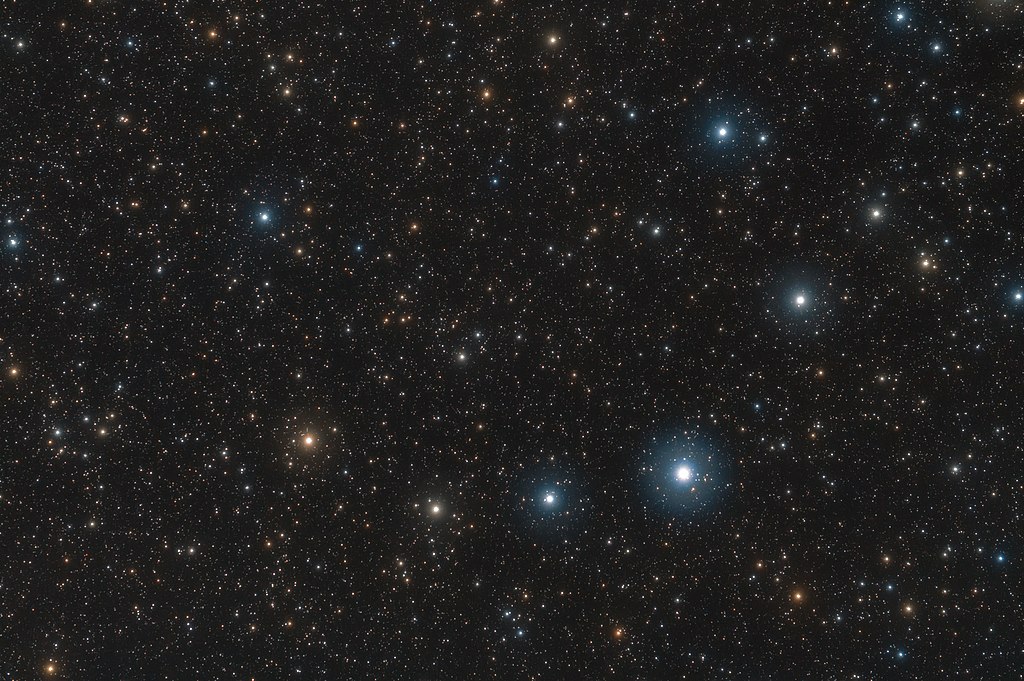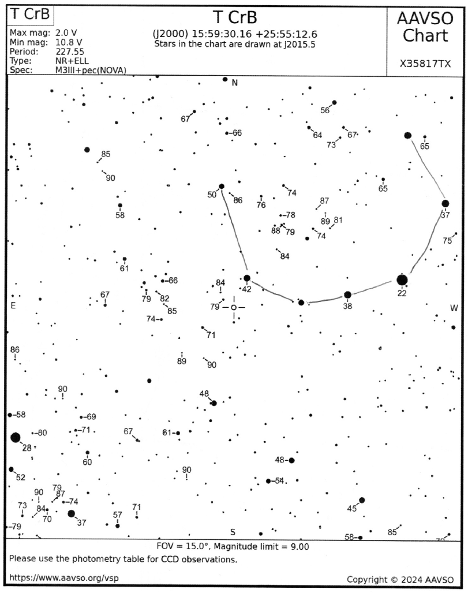
When the Blaze Star explodes, it will pay to be prepared. AAVSO is here to help. | By Brian Kloppenborg
The predicted eruption of T Coronae Borealis (T CrB) will likely be one of the most exciting astronomical events in recent memory. If it mirrors the 1946 eruption, T CrB could brighten from V~9.8 to V~1.7 in less than 24 hours, then gradually return to its pre-eruption brightness over the next 45 days. Shortly thereafter, it may brighten again to V~8, staying bright for about two months before setting back to its usual state.
To capture this event, preparation is key – and the AAVSO is here to help. Whether you’re a casual stargazer or an experienced observer, we have valuable advice for you.
If you’d like to help AAVSO record this event for its scientific value, please pay close attention to the details below. During the eruption, we will request visual photometry, multi-color optical photometry (all bands), and near-infrared photometry (JH bands). We will also request spectroscopic observation at low resolution and focused high-resolution observations of specific spectral lines.
Due to the rapid nature of this event and potential for flares and other transient phenomena, we ask that photometric observers either (a) observe continuously in a single photometric filter, or (b) cycle through as many standard photometric filters as possible while maintaining good calibration.
The AAVSO recommends that observers practice observing both T CrB and Alf CrB in advance to learn how their equipment performs at the extreme brightness ranges anticipated for T CrB.
Note: T CrB will reach solar conjunction in late November, making it extremely difficult or nearly impossible to observe safely due to its proximity to the Sun. If you attempt to observe during this time, please exercise extreme caution.
Stargazers
If you are a stargazer looking to witness the upcoming eruption of T CrB, we encourage you to do the following things to prepare.
Download a copy of the AAVSO star chart for T CrB. On my chart, I’ve connected the brightest stars in Corona Borealis to make it easier for me to locate T CrB in the sky.

Use the chart to locate T CrB in the sky and go out weekly to keep track of it. Keep in mind that our view of the sky changes slightly from night-to-night, so you’ll want to go out at least once a week to know where to look.
When the system erupts, consider capturing the moment using a camera. To produce the best images, use a tripod or other solid object to steady your camera. I suggest that you take a photo every night to document the system’s dramatic changes in brightness. While these images may not be scientifically valuable due to JPEG compression, they’ll create lasting memories for you to treasure.
Lastly, I would suggest you consider participating in the Astronomical League’s Special Observing Award on T Crb. For their level 1 award, you don’t even have to be a member of the Astronomical League.
Visual Observers
Visual observers should prepare for the eruption in advance by printing both A-scale [PDF] and B-scale [PDF] charts covering the range V~ 1.0 - 10.8 in advance. Visual observers who routinely use telescopes or binoculars are advised that suitable comparison stars may not be located within their FOV. As such, they should practice observing without binoculars / telescopes or become accustomed to rapid star hopping to obtain suitable comparison stars.
During the eruption, visual observers should collect observations three to four times per night, ideally spaced at least an hour apart.
Please be aware that Alf CrB (star 22) is an eclipsing binary with a 17 day period and 13-hour eclipse of depth 0.1 mag. Observers should make independent estimates of T CrB using both the 22 and 28 stars when T CrB is at its maximum brightness.
PEP Observers
PEP observations will be critical to establish T CrB’s behavior during the brightest phases of the eruption. PEP observers should prepare for the eruption in advance by printing both A-scale charts covering the range V~ 1.0 - 10.8 in advance [PDF] and referencing the corresponding UBVRIJH photometry table [PDF]. They should follow standard observing practices and reduce their data using the PEP data reduction spreadsheet.
During the eruption, PEP observers are encouraged to observe the system as frequently as possible due to the likely presence of flares and other transient events. PEP observers should choose in advance to either use a single filter (ideally V) or cycle between UBVRIJH filters in quick succession to produce time series observations. Observers should use HD 143894 as a comparison and HD 143107 as a check star.
Please be aware that Alf CrB (star 22) is an eclipsing binary with a 17-day period and 13-hour eclipse of depth 0.1 mag. Observers should make independent estimates of T CrB using both the 22 and 28 stars when T CrB is at its maximum brightness.
![]() Like this content? Want to see more? Support AAVSO’s day-to-day operational needs with a tax-deductible contribution.
Like this content? Want to see more? Support AAVSO’s day-to-day operational needs with a tax-deductible contribution.
CCD/CMOS/DSLR Observers
When the eruption occurs, T CrB will present a multitude of challenges to users of CCD, CMOS, and DSLR sensors. First, when the star is at maximum brightness, it will quickly saturate your detector, so you will need to take very short exposures. Unfortunately, such short exposures will be impacted highly by atmospheric scintillation, so you will need to stack many frames to bring scintillation noise down to acceptable levels. Second, as the star brightens it is unlikely that you will find suitable calibration stars in the same field of view. Thus alternative observing techniques may be required to produce precise photometry.
When T CrB is above V~6, we recommend users of CCD, CMOS, and DSLR sensors take multiple short exposures and stack them to yield an effective exposure of no less than 10 seconds in duration to reduce scintillation noise. You should collect a minimum of 3, ideally 5, stacks to provide statistical robustness to your observations.
If you cannot capture epsilon Crb (star 41) in your image along with T CrB, we recommend that you collect additional images containing stars 41, 48, 38, 28, and 22 using the same exposure and gain settings as applied to T CrB during the eruption. You should reduce the data in an identical fashion, including stacking. In this situation, you will need to reduce your data using all-sky differential photometry techniques rather than in-frame differential photometry. Observers can use the DSLR photometry data reduction spreadsheet to reduce their data.
Spectroscopic Observers
During the eruption, T CrB will brighten rapidly and feature a copious number of time-evolving emission lines. The AAVSO will request both low-resolution observations covering the entire spectrum as well as high-resolution observations of several near-UV and optical emission lines (for example, [Ne III] at 3869 and 3967Å; the Calcium Triplet at 8498, 8542, and 8662Å; and Hɑ at 6563Å). Observations of a given spectroscopic line / region should be collected 3-4 times per night during the first two weeks of the eruption and nightly thereafter until the end of the eruption.
During acquisition, care should be taken to avoid saturation within the cores of emission lines. All spectra should then be reduced according to standard procedures, including relative flux calibration (a.k.a. “instrument response correction”). The nearby A3V star HD 143894 (pi Ser) is recommended as a reference star. In addition, absolute flux calibration should be performed to maximize the scientific utility of obtained spectra.
It is recommended that spectroscopic observers practice collecting spectra on stars in the range of V ~ 9.8 to V ~ 2.0 in advance to learn ideal exposure settings for these ranges. If possible, spectroscopic observers should practice observing recent novae of stars with outflows (e.g. P Cygni stars) to understand how such features may impact their normal calibration procedures. Observers should reduce their data shortly after collection to ensure that emission lines are not saturated. ![]()

